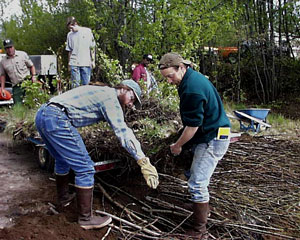Streambank Revegetation and Protection: A Guide for Alaska
Plant Care and Preparation
Vegetative Mat

A vegetative mat is the largest transplant. Dimensions of the veg mats vary from one to several square feet and may contain woody and/or herbaceous vegetation. The greatest benefit of this transplanting technique is that vegetative cover is provided immediately after the veg mat is placed at the new location. The veg mats often contain many plant species, including native plants that cannot be obtained elsewhere. Often, the main expense will be for labor and machinery used for moving and installing the veg mat.
Harvest a vegetative mat by cutting the shoots and root/soil mass into a block. The root/soil mass is cut as deeply as possible. The mat is then lifted from the ground by hand or with mechanized equipment and transported to the planting site.
Prepare the planting site by creating a depression in the soil that will accommodate the dimensions of the veg mat. Scarify or add soil as necessary to the plant site to promote root growth, then add veg mat. The sides of the veg mat should be covered by soil. If the veg mat is placed adjacent to other veg mats, make sure that the edges of the mats are not left exposed to the air, which would dry and damage the roots. If needed, soil should be placed in the spaces between veg mats to cover and protect the roots. Tap down the veg mat so that it is in direct contact with the soil, and water the entire veg mat thoroughly. Trim the veg mat shoots back by 1/4 to compensate for root loss and to promote root growth. Depending on site conditions, the veg mat may need regular watering after planting.

